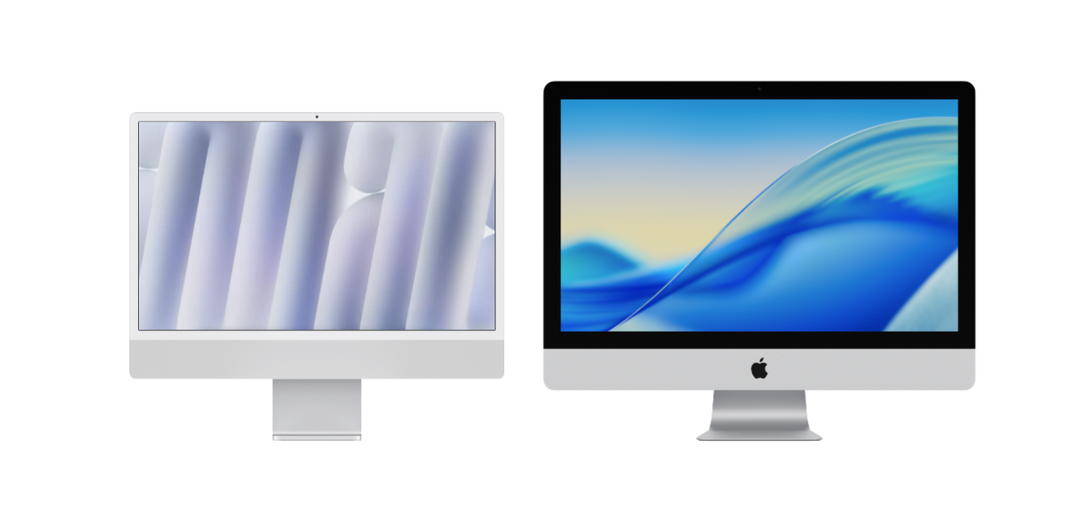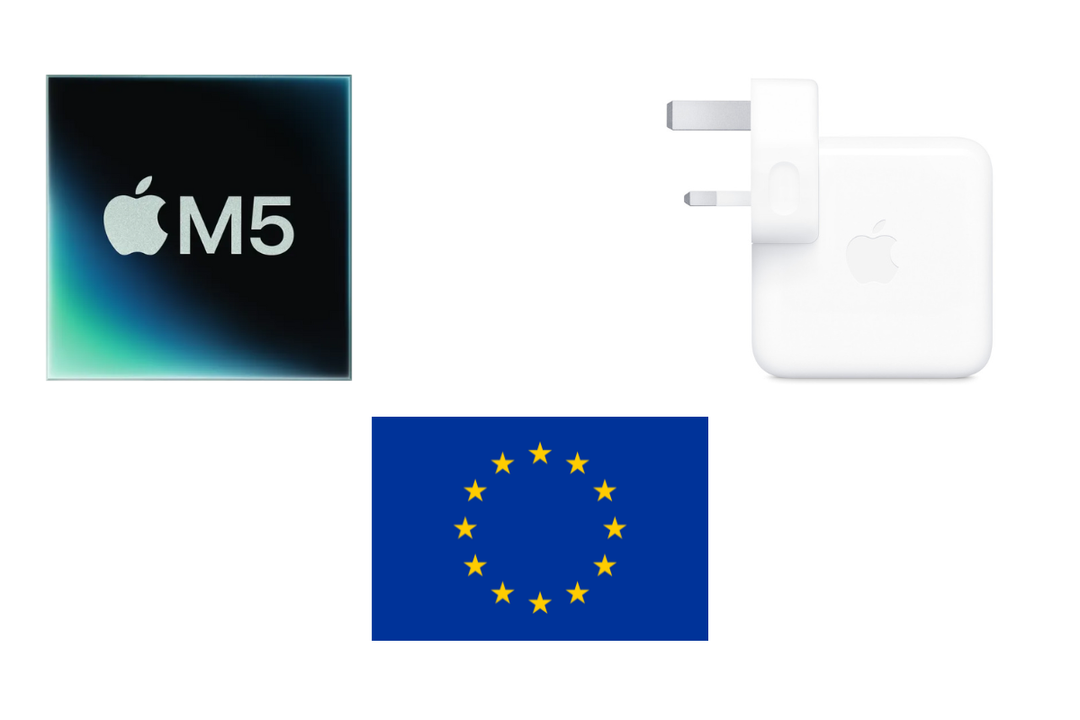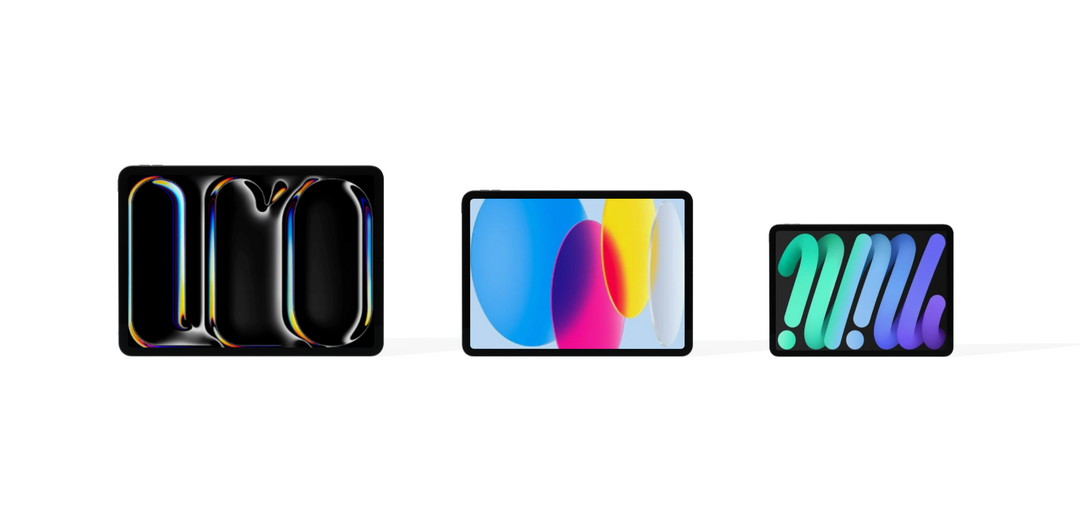Since the introduction of the iMac G3 in 1998, Apple has continuously developed the iMac line, focusing on both performance and design. Each iteration has aimed to combine functionality with a distinct visual identity, helping to set the iMac apart from traditional desktop computers. Over the years, it has been adopted in a range of settings, from home offices and educational environments to creative industries, thanks to its all-in-one form factor, ease of use and consistent hardware improvements.
With the iMac constantly evolving design and specifications, choosing the right model to suit your needs can be a challenge. This guide will walk you through everything you need to know to make an informed purchase.
Processor
The processor in your iMac affects how fast and smoothly your computer can handle everyday tasks. Apple previously relied on Intel processors for its entire Mac lineup, including the iMac, MacBook, and Mac mini, but since 2020, it has shifted to its own in-house chips known as Apple Silicon.
Intel CPUs used a traditional architecture in which the CPU and GPU had separate memory pools. In contrast, Apple’s M-series Silicon chips feature a unified memory architecture, allowing the CPU, GPU, and other components to access a shared memory pool. This integration results in significant improvements in both performance and power efficiency, compared to the more traditional structure from the intel based devices.
Processor benchmarks
Processor performance is often evaluated using benchmark scores, which are derived from running standardised computing tasks. These scores provide a comparative measure of how well a processor performs under various workloads.
Geekbench 6 Multi-Core scores for all iMac 27-inch 2020 and all Apple silicon iMac 24-inch processors, sorted from highest to lowest.
Insights from Geekbench Multicore results
Intel vs Apple silicon: The Apple M-series chip in the 24-inch iMac delivers better overall performance, including comparable or better multi-core performance than all of the Intel processor configurations in the iMac 27-inch 2020 models.
When is the processor important?: The iMac 24-inch is the stronger option for professionals who work with music production software, large office files, database management, or software development.
That said, the iMac 27-inch models with Intel i7 and i9 processors still offer strong processing performance, particularly for multi-core workloads and legacy software compatibility.
Memory
RAM (Random Access Memory) temporarily holds the data and instructions your system needs while performing tasks, enabling faster access and smoother application performance.
On the 2020 iMac, it's possible to access the memory from the back of the device, making it easy to upgrade if you need additional performance. However, on an Apple Silicon iMac, the memory is soldered directly to the logic board, meaning it cannot be upgraded at a later date.
Checking memory usage on your device
A helpful way to determine how much memory you’ll need in your new iMac is to check the memory usage on your current device. Here’s how to do it:
Check Your Current Memory:
-
Click the Apple logo in the top-left corner of your screen.
-
Select "About This Mac".
-
Under the "Overview" tab, you'll see the amount of memory (RAM) currently installed.
Monitor Your Memory Usage:
-
Open Activity Monitor (found in Applications > Utilities).
-
Click the Memory tab.
-
Use your device as you normally would throughout the day and observe the memory pressure graph and memory used.
If your memory usage is consistently high or the memory pressure graph is in the yellow or red zone, you may benefit from choosing a higher memory configuration for your new iMac.
iMac Memory options
Here are the memory configurations for each of iMac from 2020 to present:
| Model | Available Memory Options |
| 8GB, 16GB, 32GB, 64GB or 128GB (DDR4 SODIMM) | |
| 8GB or 16GB (Unified Memory) | |
| 8GB, 16GB or 24GB (Unified Memory) | |
| 16GB or 24GB (Unified Memory) | |
| iMac 24-inch M4 (4-port, 2024) | 16GB, 24GB or 32GB (Unified Memory) |
Choosing the right memory for you?
To decide how much memory you need, it is a good idea to ask yourself what you intend to use the device for.
Light user (8GB/16GB) - Internet Browsing, Word Processing applications, and watching videos
Moderate user (16GB/24GB) - Light professional work (Video editing, Photo editing, music production and large documents)
Power user (32GB or more) - High resolution video editing, photo editing and music production with multiple tracks
If you’re still unsure how much memory you need, check the software’s recommended system requirements to make sure your iMac can handle all the tasks you have in mind.
Storage
Storage capacity refers to the amount of data you can save on your iMac, including photos, videos, applications, and files. Since applications and media files are continually growing in size, it's important to choose enough storage to meet both your current and long-term needs.
If however, you're comfortable storing files in the cloud or you regularly use external hard drives, you might not need as much internal storage inside your iMac.
If you are interested in how to back up your data to iCloud why not check out our guide here.
Checking your current storage usage
If you're unsure how much storage you'll need, it's a good idea to check how much you're currently using on your old device.
To check your storage go to System Settings > General > Storage.
This will give you a breakdown of what’s stored on your device, including documents, applications, iOS files, Mail, system data, and the space used by macOS. Add this total to the storage required for any new software, and be sure to leave extra room for future files and software updates.
iMac Storage Options
The storage in both the iMac 27-inch (2020) and iMac 24-inch models is not user-upgradable, so you won't be able to increase internal storage after purchase, so ensure you purchase enough storage for your usage. However, you can connect external drives or use cloud base storage if you need additional space.
| Model | Available Storage Options |
| iMac 27-inch 2020 (i5 3.1GHz) | 256GB |
| iMac 27-inch 2020 (i5 3.3GHz) | 512GB, 1TB or 2TB |
| 512GB, 1TB, 2TB or 4TB | |
| 256GB, 512GB or 1TB | |
| 256GB, 512GB, 1TB or 2TB |
GPU
When choosing the right iMac, the GPU (Graphics Processing Unit) can be one of the most important decisions to make, especially if you are a professional that works with video editing software, CAD, animation and 3D rendering.
What is the role of a GPU?
The GPU (Graphics Processing Unit) is primarily responsible for handling visual tasks such as image processing, video playback, and animations. The faster the GPU, the better it performs these tasks. For professional work, having a powerful GPU is important to ensure your device can keep up with demanding workflows.
GPU Benchmarks
To help you find the right iMac for your needs, we’ve compiled Geekbench Metal scores for all GPU configurations available in the iMac 27-inch (2020) and iMac 24-inch models.
Please note: Apple’s M-series GPUs are exclusive to the 24-inch iMac, while the Radeon Pro 5700, 5500, and 5300 GPUs are only available on the 27-inch iMac (2020).
Geekbench Metal benchmark scores for the GPU performance of iMac 27-inch 2020 and all Apple silicon iMac 24-inch, sorted from highest to lowest.
GPU Benchmarks Explained
iMac 27-inch
The 2020 iMac comes with four graphics card options: one with 4GB, two with 8GB, and one with 16GB of video memory each offering progressively better performance. For professional video editing or advanced 3D design projects, the 16GB graphics option is the most suitable choice.
iMac 24-inch
The 24-inch iMac offers solid overall GPU performance. If you're looking for a model suitable for light editing and casual gaming, we recommend the M3 10-core, M4 8-core, or M4 10-core configurations all of which provide the extra performance needed for these tasks. For general day-to-day use, any of these models would be more than sufficient.
However, if you're a high-end user looking for maximum performance, Apple has positioned the Mac Studio as its flagship device for demanding workloads. In that case, we recommend considering a Mac Studio instead. You can view our full range of Mac Studio models here.
Ports and Connectivity
There are several different port configurations across the iMac 27-inch and 24-inch models, with the 27-inch offering the most extensive selection.
iMac 24-inch
When Apple launched the 24-inch iMac in 2021, they shifted to a more streamlined design, removing traditional ports like USB-A and the SD card reader. Instead, the 24-inch iMac focuses on Thunderbolt ports, offering broad compatibility through adapters. It comes in two configurations: a 2-port and a 4-port model. With the 4-port version, Ethernet is integrated into the power adapter for a cleaner setup.
iMac 27-inch 2020
One of the standout advantages of the 2020 27-inch iMac is its extensive range of built-in ports. It comes equipped with two Thunderbolt 3 ports, an SD card slot, four USB-A ports, and Gigabit Ethernet as standard, ideal for users who prefer to avoid adaptors and external hubs.
From left to right, iMac 24-inch 4-port, iMac 24-inch 2-port, iMac 27-inch 2020
iMac Port Configurations
Here is a list of the ports available on both the iMac 27-inch (2020) and the iMac 24-inch models with Apple silicon.
| Model | Ports and Connectivity |
| iMac 27-inch (2020) | 3.5 mm headphone jack |
| iMac 24-inch M1 (2-port) iMac 24-inch M3 (2-port) | 3.5 mm headphone jack |
| iMac 24-inch M1 (4-port) iMac 24-inch M3 (4-port) | MagSafe 3 charging port, two Thunderbolt 4 (up to 40Gb/s) ports, 3.5mm headphone jack 3.5 mm headphone jack |
| iMac 24-inch M4 (2-port) | 3.5 mm headphone jack |
| iMac 24-inch M4 (4-port) | 3.5 mm headphone jack |
While the iMac 27-inch offers more built-in ports for connecting peripherals and storage devices, such as USB-A and SD cards, you can still use an adapter or hub with the iMac 24-inch to connect traditional devices via its Thunderbolt (USB-C) ports.
If you are looking for an Apple silicon desktop with a variety of ports, the Mac Studio or Mac Pro would be a good choice.
Display
What makes the iMac a popular choice among professionals is Apple’s advanced display technology, featuring high-resolution Retina screens with 500 nits of brightness and a wide P3 colour gamut. This level of screen quality is especially valuable for creative professionals working in graphic design, video editing, and film production.
From left to right, iMac 24-inch, iMac 27-inch
| Model | Display |
| iMac 27-inch 2020 | 27-inch (diagonal) 5K Retina Display |
| iMac 24-inch M1 iMac 24-inch M3 | 24-inch (diagonal) 4.5K Retina Display |
| iMac 24-inch M4 | 24-inch (diagonal) 4.5K Retina Display |
While the iMac 27-inch native display is larger and higher resolution, both the 27-inch and 24-inch iMac shares similar brightness level and colour accuracy, making both excellent choices for colour-critical and visually accurate work.
The main difference is that both the 27-inch iMac and the 24-inch M4 iMac can be configured with nano-texture glass, which is ideal for users working in bright environments, such as industrial lighting or areas with abundant natural light, as it helps to reduce glare and reflections on the screen.
External Display Support
External display support on the iMac is designed to work alongside its built-in native display, allowing for an extended or mirrored desktop experience. Both the 27-inch and 24-inch iMac support external displays, but the level of support depends on the specific configuration, particularly the processor and graphics hardware.
Below is a breakdown of each iMac configuration and the level of external display support it offers.
| Model | Display |
| iMac 27-inch 2020 | One 6016-by-3384 (6k) external display at 60Hz, or |
| iMac 24-inch M1 iMac 24-inch M3 | One external display with up to 6K resolution at 60Hz |
| iMac 24-inch M4 | Up to two external displays with up to 6K resolution at 60Hz or one external display with up to 8K resolution at 60Hz |
If your workflow depends on multiple external displays, the 27-inch Intel iMac with AMD Radeon Pro 5700 or 5700 XT graphics is still a strong option, it supports up to two external 6K displays at 60Hz.
In contrast, most Apple Silicon models are more limited: the M1 and M3 models only support one external display. However, Apple’s latest 24-inch M4 iMac changes that, specifically the higher-end configuration with the 10-core GPU and four Thunderbolt ports. It’s the first and only Apple Silicon iMac that natively supports up to two external 6K displays at 60Hz.
Camera
Both the iMac 27-inch and 24-inch come with a high-definition camera positioned at the top of the device, making them perfect for video calls and meetings. Coupled with a built-in microphone, they’re ideal for remote workers, virtual meetings, or keeping in touch with family and friends.
| Model | Display |
| iMac 27-inch 2020 | 1080p FaceTime HD camera |
| iMac 24-inch M1 iMac 24-inch M3 | 1080p FaceTime HD camera |
| iMac 24-inch M4 | Up to two external displays with up to 6K resolution at 60Hz or one external display with up to 8K resolution at 60Hz |
The 24-inch iMac M4 boasts several significant improvements from the other iMac models, including a higher-resolution camera and a new Desk View feature. Desk View expands the camera’s field of view to include your desk or can be switched to show only the desk area. This is especially useful for anyone giving demonstrations, such as illustration concepts, working through maths equations, or showcasing products for social media, all without needing to adjust the camera or use an external webcam.
Size and APPEARANCE
Apple re-designed the iMac with the introduction of the iMac 24-inch M1, removing the Apple logo from the front of the device, decreasing the size of the stand and including a variety of colours to choose from.
Dimensions
The iMac 24-inch does not only a smaller screen, it's also thinner than the iMac 27-inch. Please see the table below for the dimensions of the iMac 24-inch vs iMac 27-inch.
| Model | Dimensions | Weight |
| iMac 27-inch 2020 | 51.6 cm H x 65 cm W x 20.3 cm D | 8.92 kg |
| iMac 24-inch | 46.1 cm H x 54.7 cm W x 14.7 cm D | 4.46 kg |
Appearance
There is a big difference when comparing the iMac 27-inch to the 24-inch in terms of appearance. The 27-inch iMac comes in one colour the classic Apple silver, whereas the iMac 24-inch comes in a variety of different colours. The colours are Silver, Blue, Green, Pink, Yellow, Orange and Purple. While all of the iMac 24-inch's have the same colour options, there are slight changes to the colour tones for the M4 version.
| Model | Colour Options |
| iMac 27-inch 2020 | Silver |
| iMac 24-inch M1 iMac 24-inch M3 | Silver, Blue, Green, Pink, Yellow, Orange Purple |
| iMac 24-inch M4 | (Different tone of colour) Silve, Blue, Green, Pink, Yellow, Orange, Purple |
iMac 24-inch (Rear) colours Silver, Blue, Yellow, Purple, Pink and Orange
Why choose refurbished
Now that you have decided on what the best iMac would be for your needs, why not consider refurbished. At Hoxton Mac, we have the largest range of refurbished iMac in the UK ranging from the 2020 iMac 27-inch to the latest M4 24-inch iMac.
Benefits of buying refurbished
Refurbished iMacs from Hoxton Macs are professionally restored to the highest standard, ensuring full functionality and reliability. Each device is backed by a one-year hardware warranty and you'll also save significantly compared to buying new.
Need Help?
If you have questions or want more information about refurbished iMac at Hoxton Macs, we're always here to help.
-
Phone: 020 8819 3244
-
Email: info@hoxtonmacs.co.uk
Explore our full range of refurbished iMac models here.



